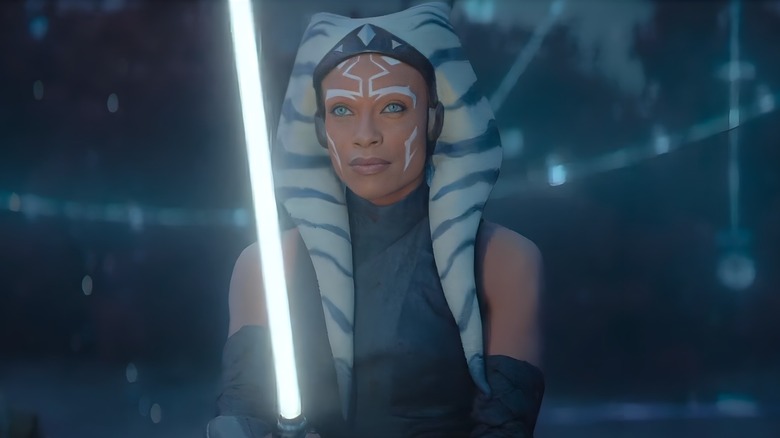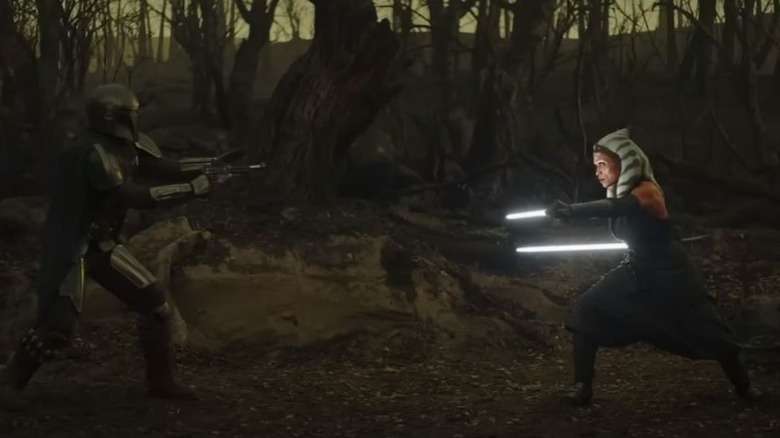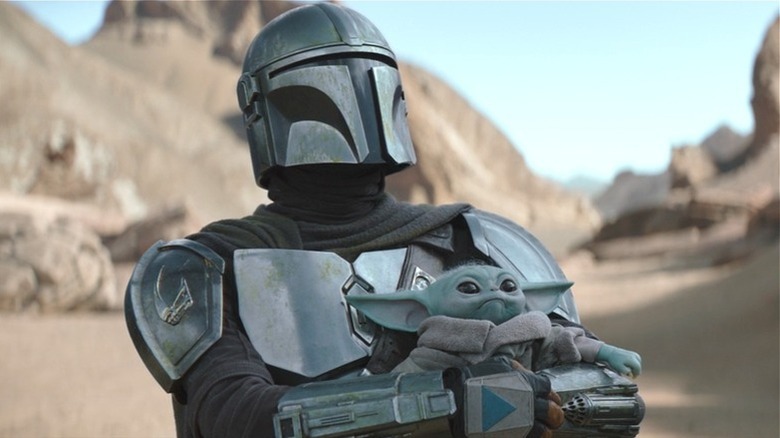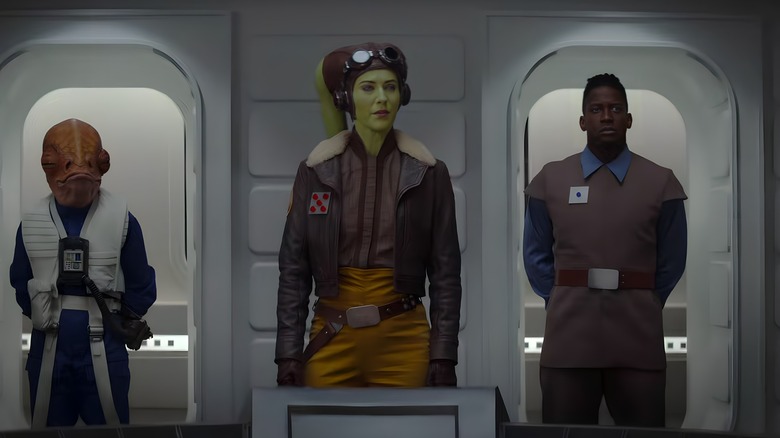Move Over, Mandalorian: Ahsoka Is Already The Most Important Star Wars Show
Contains spoilers for "Ahsoka" Season 1, Part 3
When "The Mandalorian" premiered, the opportunities serialized storytelling provided to the Galaxy Far, Far Away were endless. In Din Djarin (Pedro Pascal), the show had a cool protagonist who was brand new to the franchise, yet seemed familiar enough to believably interact with just about any existing character in the franchise. He then proceeded to do precisely that.
The show quickly established the Mandalorian bounty hunter as a lone gunman type in a space Spaghetti Western, which was a great vehicle for meeting all sorts of characters. Sometimes, Din would take center stage. In other episodes, he'd be happy to hover in the background while a healthy mix of familiar faces and exciting new ones take the spotlight. "The Mandalorian" was the perfect package to show off the stories the Disney+ "Star Wars" shows could tell, and while the likes of "Andor" have definitely given it a run for its money, it has maintained its centerpiece status.
That is, until "Ahsoka" arrived.
In just three episodes, Ahsoka Tano's (Rosario Dawson) namesake series has taken over. With its "Star Wars Rebels"-centric storytelling, it has already cemented its place as the most important "Star Wars" show out there, period. But how could "Ahsoka" dethrone the seemingly invincible "The Mandalorian" despite only having three episodes to contend with the latter's three full seasons? A lot of it has to do with the wealth of existing characters "Ahsoka" has access to, as opposed to "The Mandalorian's" increasingly meandering storytelling choices. Let's take a look under the hood.
Both shows are a journey, but only one has a tangible destination
What is "The Mandalorian" about, anyway? Three seasons in, we're still none the wiser. Is Din Djarin ultimately protecting Grogu? Sure, but that story is really about Grogu's path as a "chosen one" type — Din's just the benevolent father figure. Battling the remnants of the Empire? Nah, he seemed content to mind his own business before Grogu entered the picture and events conspired to make Moff Gideon (Giancarlo Esposito) his enemy. Restoring Mandalore? He'd like it as much as the next Mandalorian, but at the end of the day, that's Bo-Katan Kryze's (Katee Sackhoff) game, with Din playing the sidekick. Resuming his status as a Mandalorian? Actually, yeah, but come on. He loses it during his guest stint in "The Book of Boba Fett" and fixes the situation in like three episodes. That's not a driving motivation, it's a side quest.
At the end of the day, Din is a serviceable supporting character who somehow ended up having his own series. The end result is essentially the "Seinfeld" of the Galaxy Far, Far Away — fun, but ultimately a show about nothing. Meanwhile, "Ahsoka" doesn't mess around with unfocused storytelling. The show immediately states its mission in the season premiere, spends Part 2 bringing (at least some of) the "Rebels" band back together, and goes all in with Jedi training and space dogfights in Part 3. All of this is done with a clear mission in mind. There are very specific villains who need to be stopped, a classic "Rebels" name who needs saving, and an array of impressive characters with their own, clear motivations on both sides of the clash.
Just like "The Mandalorian" was when it started, "Ahsoka" is just the beginning. However, as opposed to the ever-present randomness of Mando's adventures, it's already clear what "Ahsoka" has the potential to become: A worthy sequel to "Rebels," and the launching pad for a whole live-action universe of interconnected characters from the animated series. Talk about a mission statement.
Din Djarin is a cool protagonist, but not a particularly deep one
"The Mandalorian's" somewhat inconsistent storytelling is, of course, a side effect of the show's all-but-stated mission to act as a vehicle for cameos and live-action introductions for assorted "Legends" characters and concepts. Unfortunately, the show's tendency to have Din Djarin constantly interact with awesome characters is that the Mandalorian himself ends up lacking depth. In true Boba Fett-during-the-original-trilogy fashion, he's a blank-slate character whose goals and abilities flux with the show's needs on a weekly basis.
Din is precisely as awesome or clumsy as any given episode needs him to be, and the show's jumbled nature makes much of his storyline look like a series of low-stakes side quests: kill an enemy, help a friend, fix a robot, gain new armor. At this point, a peasant could ask him to collect 10 Mudhorn ... horns, and it wouldn't look out of place among the rubble.
This approach worked when the show started. However, "The Mandalorian" Season 3 shows that the concept is running out of steam, to the point that the show has promoted the vastly more complex and capable Bo-Katan Kryze to main character status while pushing Din to the sidelines. Even Pedro Pascal himself thinks Bo-Katan is the most exciting character in "The Mandalorian," so it's not exactly surprising that Season 3 might make a viewer wonder just which particular Mandalorian the show is about.
Ahsoka's show comes pre-packaged with its own lore
Meanwhile, "Ahsoka" draws from a far more clearly defined talent pool. It doesn't need to artificially introduce random guest characters, since its central cast is already full of names who are at least as interesting as "The Mandalorian's" Bo-Katan ... and come from the same corner of the franchise, too. "Ahsoka" can freely use pretty much any existing character from the animated series to achieve the same punch-the-air effect that "The Mandalorian" has given us so many times with its various character cameos and introductions.
The difference is that, unlike Din Djarin, Ahsoka Tano is a part of that world herself. As such, any "The Clone Wars" and "Rebels" characters who turn up in the show come pre-packaged with their own lore and a web of existing relationships with her and the other characters. Here, someone like Hera Syndulla (Mary Elizabeth Winstead) can be an organic part of the story, with a job, friends, and political adversaries that all draw from her lengthy history as an animated character. In "The Mandalorian," she would likely be a cameo of the week like Zeb Orrelios (Steve Blum), with little impact on the grander plot.
Ahsoka herself is arguably the most fully realized character in the entire franchise, with 84 animated episodes of character development up her sleeve even before she entered the realm of live-action. Combine this with the fact that she's far from alone, and it's pretty clear that she and the other extremely fleshed-out "The Clone Wars" and "Rebels" characters are the perfect centerpiece for the Disney+ shows going forward.
Watch a couple of episodes of "The Mandalorian" and imagine how cool it would be if Ahsoka turned up for a guest spot. Meanwhile, after three episodes, "Ahsoka" has so much interesting stuff going on that a Din Djarin cameo would bring little to the show. After all, this is "Ahsoka's" world now, and no one has time for a Mando rando in a show that's busy continuing one of the most beloved "Star Wars" stories in glorious live-action.



